We would love to have more images to add to our collection. They are primary sources that give us the Fort in a moment in time.

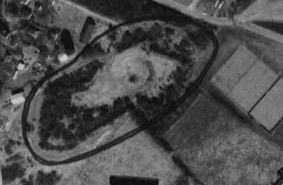
Gloria Schmidt's research notebook of topics in Portsmouth, RI history.
October 31, 2021
October 31, 2021
Portsmouth History Butts Hill Fort, maps 2 Comments
We are collecting maps and blueprints that give us an image of Butts Hill Fort. If you have one to add to our collection, let me know, we would be happy to have it. Maps and diagrams are such an important primary source and we can learn from them.
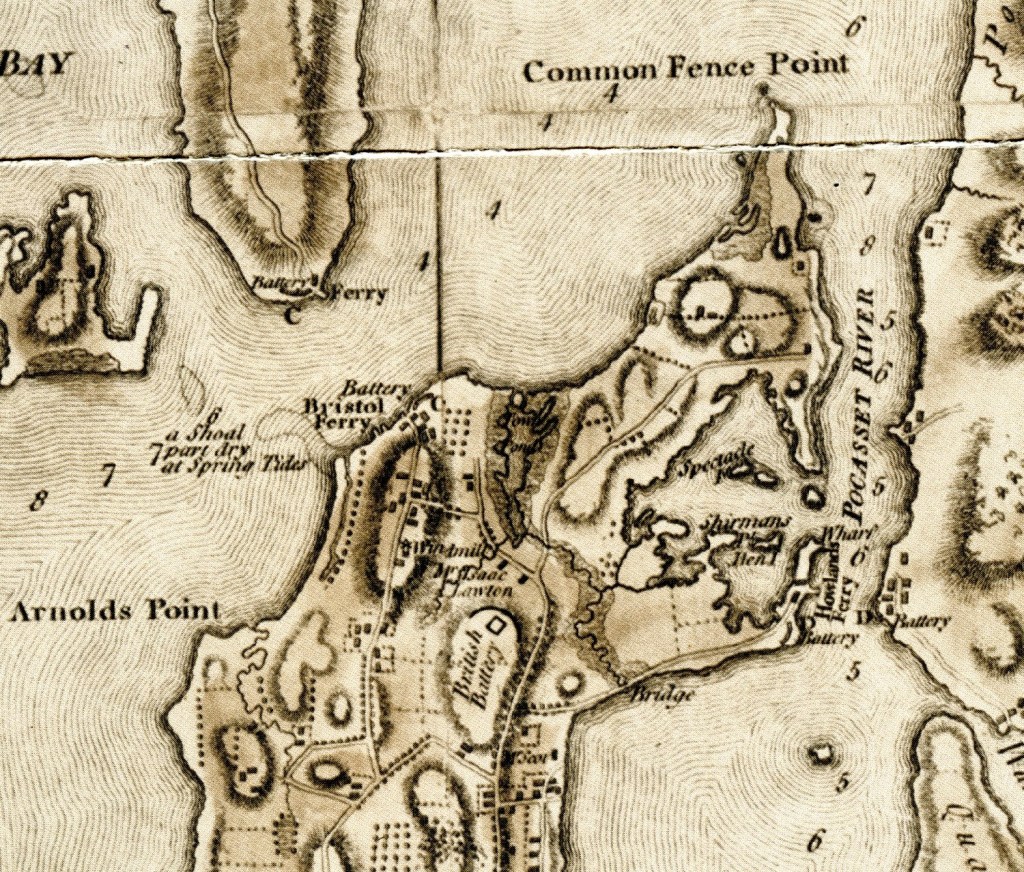
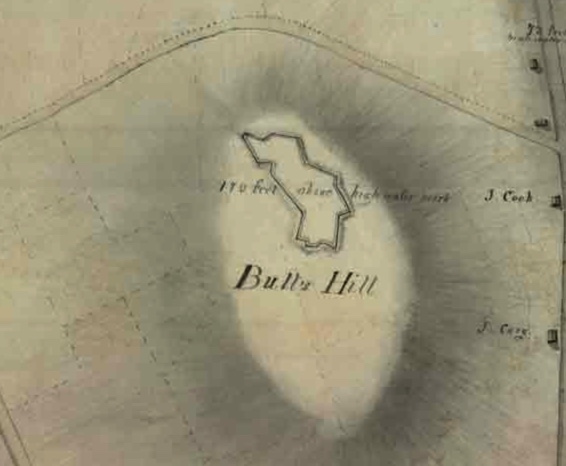
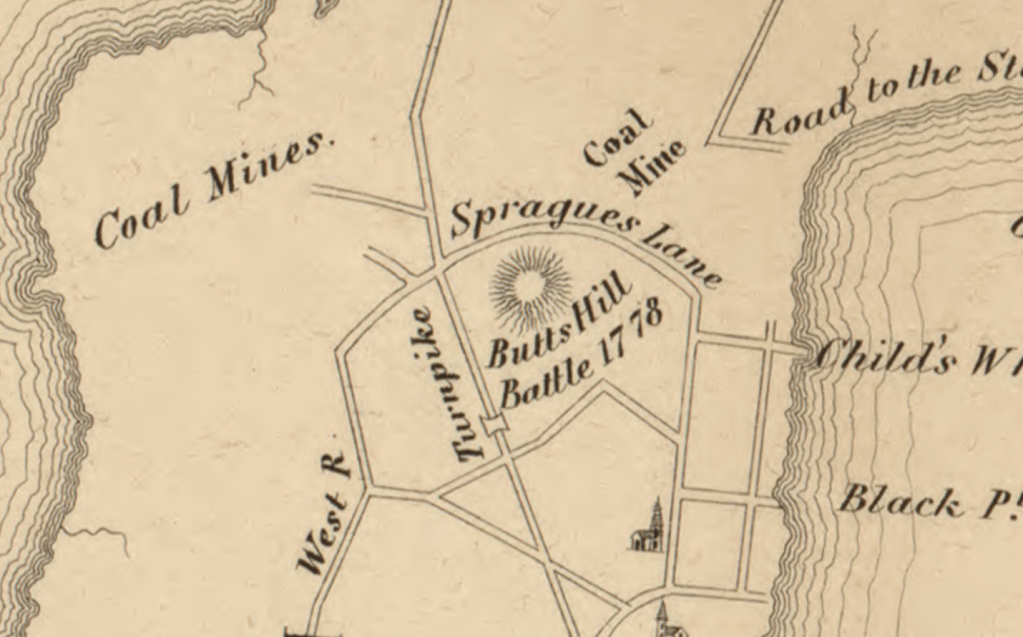
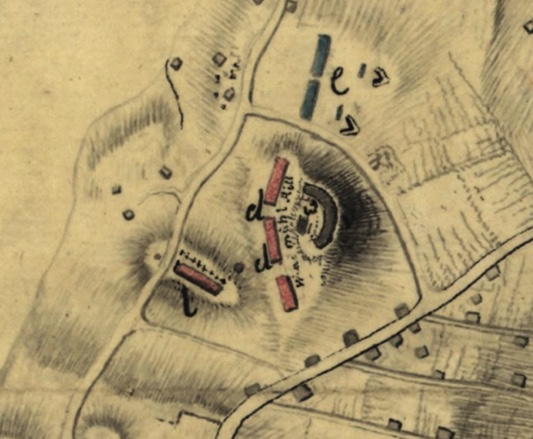
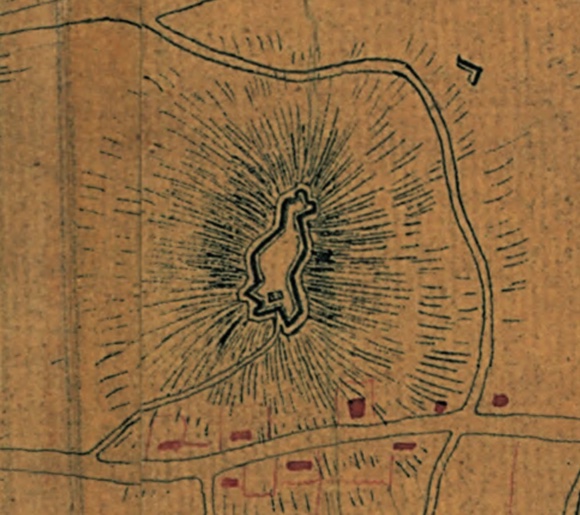

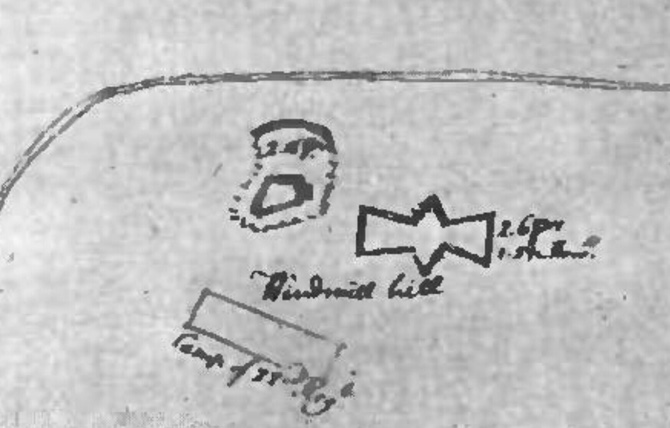
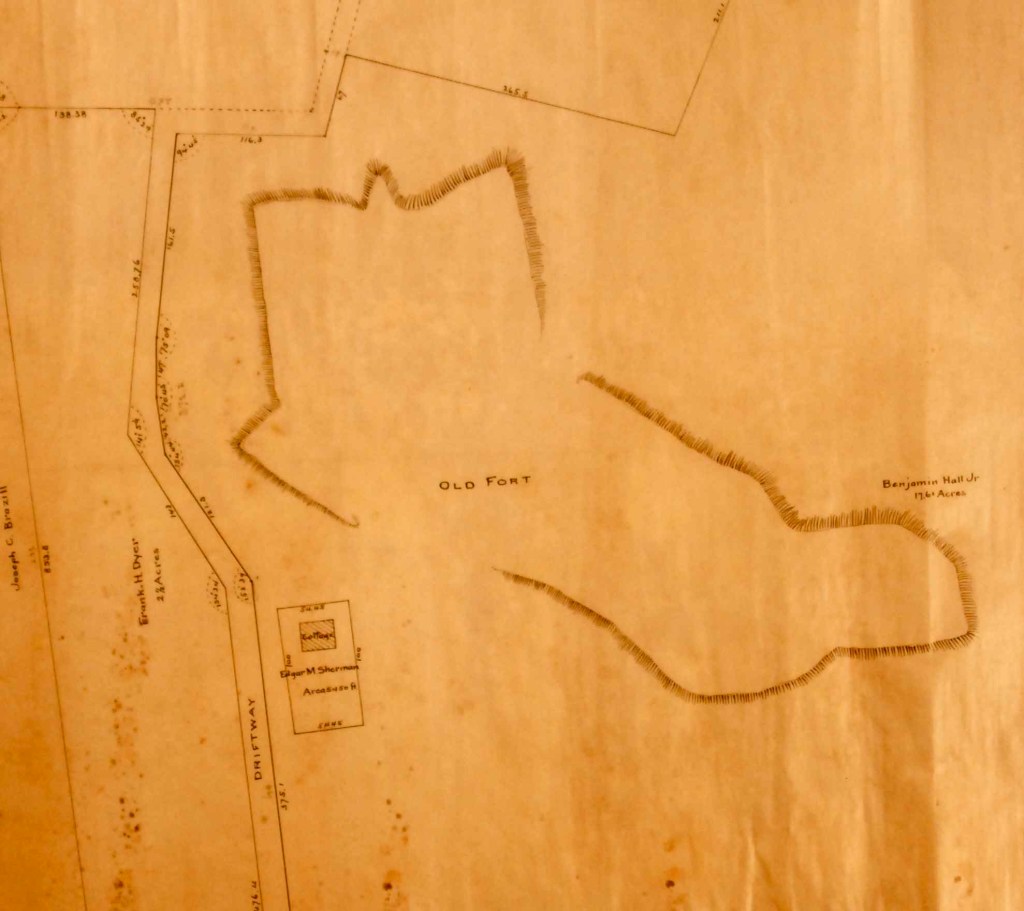
October 29, 2021
Portsmouth History Glen Farm, Graveyards, Slocum Leave a comment
Graveyards don’t scare me. As an historian I sometimes feel like I know some of the people whose graves I pass. A few years ago my husband and I volunteered to survey the little graveyard by the barns at Glen Farm as part of a state-wide effort to monitor the historic cemeteries. The sturdy stonewalls protect it from the bustle of equestrians who come to ride or take care of their horses. Once you step inside that tree shaded historical cemetery you may notice that the gravestones tell the story of two families, the Cundalls and the Slocums. The Cundall burials range from 1810 to 1820 and they are on the westside of the plot and the head of the stones face west.
The headstones for the Slocum family are of an earlier time – 1703 to 1722. They lie in the northeast corner of the plot and the engravings face south. According to the database of historic cemeteries, the grave of at least one young Slocum lies here unmarked by a stone. Two of Giles Slocum’s sons died together in 1712. Their names were Matthew and Giles. How did two of the Slocum children die together? It was murder so evil that even Boston newspapers (Boston News Letter-June 27th, 1712) carried the account.
“An Indian servant man belonging to Mr. Giles Slocum of Portsmouth carried out to sea in a canoe two of his Master’s sons, one of them ten, the other nine years old. …Being examined before authority he confessed that he knocked the eldest child in the head with a paddle. Seeing the youngest crying, he overset the canoe by design and swam to shore by himself.”
Later reports tell us that the servant’s name was Job. A fitting name for one who would find himself “now in irons in prison till he is tried for murder.” I would assume it would be the same jail our friend Thomas Cornell was locked in forty years before. Why did Job commit the crime? Was he angry at the boy? Was he drunk? – a common problem in those days. We can only wonder. We will never know his motive, but we do know his end. He was hung in chains (gibbeted) at Miantomi Hill. That’s the same place Thomas Cornell met his end. Whereas Thomas was duly buried, Job was not. Criminals suffered the gibbet if their crimes were particularly heinous. The body is left suspended and decaying for all to see. He was left to rot on the gallows for two years or as an early historian would note, “until his bones fell apart from decay of the flesh and ligaments.”
October 25, 2021
Portsmouth History Battle of Rhode Island, Black Regiment, Bloody Brook, Hessians 3 Comments
It seems appropriate during Halloween week to write about a graveyard and a brook that runs red with blood. Portsmouth has many legendary places and Hessian’s Hole and Bloody Brook are among them..
Hessian’s Hole is among the historical graveyards listed in Portsmouth, Rhode Island. This gravesite has its origin in the Battle of Rhode Island. Among the English troops that occupied Aquidneck Island were German soldiers, Hessians, who came primarily from the Hesse-Cassel region. During the Battle, Hessian and British troops chased the Americans who were trying to retreat from the island after the French fleet abandoned the campaign for Newport to repair their ships. Around Turkey Hill on the West Main Road, the Hessians rushed the hill to take an American redoubt.
From Captain Malsburg’s journals: “Here they experienced a more obstinate resistance than they expected. They found large bodies of troops behind the work and at its sides, chiefly wild looking men in their shirt sleeves, and among them many negroes.”
The Hessians had encountered the Rhode Island First Regiment – known as the Black Regiment. The Hessians were repulsed at least three times and according to General Sullivan’s account, 60 Hessians were left dead.
“Hessian’s Hole” was the name commonly used for the burial ground of these German soldiers. You can find it on modern online maps, but there are debates about just where it is located. One possible location is on the grounds of Portsmouth Abbey. Other sources claim it is by the top of Lehigh Hill on route 114 where there is a look-out. According to the state database of historical cemeteries, “This cemetery is just south of one of the holes on the golf course on the edge of the woods. It is on land of Portsmouth Abbey – must get permission to visit. These are the graves of Hessian soldiers who died during the Revolutionary War.”
Do the ghosts of the Hessian soldiers make an appearance now and then? A Daily News account in May of 1960 included a comment that the Hessian soldiers march on foggy nights around the Hessian’s Hole.
“Bloody Brook” is a nickname for Barker’s Brook because it was said to run red with the blood of the soldiers that died in that skirmish. Route 24 has interfered with the natural course of the brook, but you might still see portions of it.
References:
Rhode Island Historical Tracts #6. Copyright by Sidney Rider 1878
October 22, 2021
Portsmouth History John Hancock, Paul Revere 1 Comment
Did Paul Revere and John Hancock actually fight in the Battle of Rhode Island? So many online resources mention them being there.

Yes, they came on Aquidneck Island with Sullivan’s forces. Lieutenant Colonel Paul Revere and his son, who was a lieutenant and about 17 years old, were sent to to reinforce General John Sullivan. Among the 10,000 or so of the forces that gathered at Tiverton were John Hancock and his Massachusetts Militiamen including Paul Revere. As a senior major general Hancock took command of 6000 soldiers. Hancock delayed going to camp in Rhode Island, but his role wasn’t working on strategic plans. His presence was more of a symbolic one. When the Americans crossed over to Aquidneck Island, Revere’s regiment was responsible for erecting and maintaining artillery batteries on the island.
The plan was that the American forces and the French Navy would combine to rout the British from their occupation of Newport. Unfortunately the French ships were damaged in a storm. French Admiral d’Estaing decided to head to Boston for repairs. Hancock wrote d’Estaing asking him to reconsider, but the French left at midnight on August 21, 1778. The Americans knew that their mission of freeing Newport was nearly impossible without the help of the French. The militias began to desert. Hancock and his militia, including Paul Revere, headed home to Boston. Hancock asked Lafayette for a letter of introduction to d’Estaing and the Frenchman obliged. John Hancock was home in Boston by August 26th. Sullivan would safely retreat from the island beginning on August 29th. A Tory newspaper in New York would publish a parody of Yankee Doodle and one of the stanzas mentioned Hancock.
“In dread array their tatter’d crew, Advanc’d with colors spread Sir, Their fifes play’d Yankee Doodle do, King Hancock at their Head Sir.”
No, Revere and Hancock did not fight in the Battle of Rhode Island. They went home to Boston before the battle began.
Resources:
Fowler, William. The Baron of Beacon Hill: A biography of John Hancock. Boston, Houghton-Mifflin, 1979.
October 20, 2021
Newport celebrates the French troops coming to the island, but the French were at Butts Hill Fort in Portsmouth as well. American troops, including members of the Black Regiment, lived at “Camp Butts Hill” and worked together on reconstructing the Butts Hill Fort in 1780-1781. Ultimately the French and Americans joined forces and headed south towards ultimate victory at Yorktown.
As background it is good to remember that the French arrived on Aquidneck Island on July 11, 1780. There were American troops assigned to the fort to support the work of the French troops in restoring the fortifications at Butts Hill. We get a glimpse of their work through the Orderly Book of Ebenezer Thayer, Jr. The orderly book is a record of the day to day activities of the Massachusetts militia commanded by Thayer and assigned to support the Expedition Pariculiere, the French Expeditionary Army under the command of Rochambeau. They were on Aquidneck Island and stationed at “Camp Butts Hill” from August 16th to November 28, 1780.
From the Orderly Book:
October 12, 1780: “It is requested by General Rochambeau and Commander Jacobs that every officer not on duty will attend upon the works for the purpose of encouraging the soldiers and completing the fort.”
October 16, 1780: “There are four men to be detached from the brigade to attend constantly on the French Masons until the stone pillows of the Fort are completed and two masons detached to assist the French Masons until the works are finished and for their service they shall receive half a pint of rum a day when in the store.” Their provisions are ready for them so that they can complete the Fort works in a timely manner.
There are other connections between the French and American forces.
In April, the Butts Hill Fort Restoration Committee was notified that the National Parks Service has made Butts Hill Fort a location on the Washington-Rochambeau Revolutionary Route National Historic Trail. The Washington-Rochambeau National Historic Trail (WARO) identifies the land and water routes that General Washington and the Continental Army, and General Rochambeau and French forces, followed in 1781 during their 14-week march from Newport, Rhode Island to the Siege of Yorktown, Virginia.
On March 6, 1781, three months before the French army departed from Newport, General Washington visited Count de Rochambeau to consult with him concerning the operation of the troops under his command. Washington was hoping to encourage Rochambeau to send out his fleet. During the visit, Washington informed Samuel Huntington, the President of the Congress, that “In consequence of previous arrangements between the Count de Rochambeau and myself I found between eleven and twelve hundred of the French Grenadiers and Infantry already embarked and the Fleet nearly ready to sail. They however did not put to sea until the evening of the 8th.” On March 13, 1781, Washington left Newport and journeyed overland to Providence. On his departure he was saluted by the French with thirteen guns and again the troops were drawn up in line in his honor. Count de Rochambeau escorted Washington for some distance out of town, and Count Dumas with several other officers of the French army accompanied him to Providence. We know that General George Washington travelled by Butts Hill Fort on the old West Main Road on his way to the Bristol Ferry because the West Road was the customary route from Newport to the ferry. Washington’s aide, Tench Tilghman, recorded the fee for the Bristol Ferry on the expense book.
Just like the American and French forces were working on repairing and improving the fort, the Butts Hill Fort Restoration Committee is working on rehabilitating the area as a park where visitors can learn about the battles and the brave patriots who fought there. Hopefully by 2026 Butts Hill Fort will be a center for celebrations of the 250th Anniversary of the War for Independence.
References:
Bulletin of the Newport Historical Society, February 1913. Visit of General Washington to Newport in 1781, Mrs. French E. Chadwick. Memoranda of Col. Tench Tilghman, one of Washington’s Aides.
Rochambeau map collection: Library of Congress
Quahog. org: Washington’s Third Visit to Rhode Island
Orderly Book of Ebenezer Thayer: Huntington Library
October 18, 2021
Portsmouth History Battle of Rhode Island, Butts Hill Fort, Portsmouth History Leave a comment
On Sunday, October 17, 2021, old Butts Hill Fort was lively once more. Re-enactors in Revolutionary era uniforms demonstrated the same military drills used in the War for Independence. It was a perfect example of what Dr. Roderick Terry had in mind when he donated the land around Butts Hill Fort to the Newport Historical Society in the 1920s. He envisioned a “place where the public may enter, view and study the battle field on which our soldiers fought, be enlightened in the battles thereon fought, and in American history.” Through the years the land passed into the hands of the Town of Portsmouth, but the town still has Terry’s mandate to use Butts Hill Fort as a public space where citizen can learn about the Battle of Rhode Island and our history. The Living History Day is a perfect example of how we can use the fort in the spirit it was given to us. Another mandate given was that the fort should be maintained. The Butts Hill Fort Restoration Committee (an outgrowth of the Portsmouth Historical Society) has been working towards a goal of clearing the vegetation that threatens the earthen fortifications. The committee has already begun to bring the fort out of the trees and bushes. There is much to do, but their goal is to preserve this historic battlefield, create a park with walking trails around it and prepare it for Revolutionary War celebrations around 2026. Visiting an historic site is certainly a valuable way to learn our history and the committee is doing the research to create informative signage and educational stations. How can we use this historical gem in our community? A gathering spot for community celebrations, for scout activities, staging area for re-enactments, and opportunities for heritage tourism are just some ideas that come to mind.
Are you interested in volunteering for some cleanup or other activities? Email Seth Chiaro at seth.chiaro@gmail.com.
October 6, 2021
Portsmouth History Alice Lake, Butts family, Thomas Cornell 3 Comments
Everyone asks how Butts Hill got its name. I am not a genealogist, but I tried to research the Butts family and their role the community. Like many of the Portsmouth families, the genealogy includes connections with founding families – Coggeshall, Wordell, Cook, Potter, Briggs, Cornell – to name just a few.
Thomas Butts seemed have originated the family in America. He joined the Plymouth Colony in 1660 but he quickly settled in Rhode Island. His wife was Elizabeth Lake, the eldest daughter of Alice Lake who was hung for witchcraft in Dorchester in 1651. Alice had just lost a baby and in her grief she insisted she saw the baby alive. She had a chance to recant at her trial, but did not. Her case is an early example of a witchcraft trial and some speculate her depression led her to view the hanging as justified. Her husband, Henry, moved to Portsmouth almost immediately and the family was divided until they all settled in the Little Compton area. Henry’s son, David Lake, married Sarah Cornell, the widow of Thomas Cornell, Jr. David’s sister, Elizabeth Lake, would marry Thomas Butts.
Thomas Butts was admitted as a freeman in Portsmouth in May, 1660. Thomas sought to exchange land with the town in 1665, but thought better of it when the land he was swapping for proved worthless. In 1666 he purchased two acres of land in Portsmouth from Richard Bulger for a cow and ten shillings in wampum. The Early Records of the Town of Portsmouth list him as a surveyor of cattle in 1679. Like many men at that time, he had property in Dartmouth and Tiverton at the same time he was in Portsmouth. He died in Little Compton in 1702 and his will refers to him as a cooper. One of his daughters, Elizabeth, married Joseph Cundall. The Cundalls would be a prominent Portsmouth family and the Glen area was once known as “Cundall’s Mills.”
Thomas’ son, Zaccheus lived in Little Compton. He was married to Sarah Cornell, the daughter of Thomas and Sarah Earle Cornell. Thomas was tried and convicted (with testimony involving a spirit) of murdering his mother. According to the Little Compton Historical Society, Zaccheus was a scoundrel and abandoned his wife and five children. He sold his daughter Mary as an indentured servant.
A son, John, was born to Zaccheus and Sarah in Little Compton in 1691. The family history is complicated, but John would have had his grandfather (Thomas Cornell, Jr.) hung for murder and his great grandmother (Alice Lake) hung for witchcraft. He moved to Portsmouth and is recorded to have had two wives. One of his wives was from the Wordell family and the other, Abigail, was from the Briggs Family. This Briggs connection is interesting because what we call Butts Hill was once called Briggs Hill. On January 15, 1725 John bought from Caleb Bennett a windmill and about one rood (about a quarter of an acre) of land on Windmill Hill (now called Butts Hill). He erected a house by the windmill. He must have owned other land in Portsmouth since he had been considered a freeman for some time. A 1726 map of the Newtown area of Portsmouth shows him having a small parcel of land on what would be the East Path (East Main Road today). John is recorded as being a tavern keeper. He was accused in 1747 of allowing card playing at his tavern and his future son-in-law Thomas Cook was called as a witness against him. John’s daughter Sarah married Cook in 1763. When John died in 1768 he left his daughter, Sarah Butts Cook, “my dwelling house and land, bounded southerly on land from my father-in-law Enoch Briggs, next to David Lake.” This is as far as I can trace the Butts presence on this Windmill Hill (Butts Hill). Some of Butts land was passed down through the Cook family. One Butts family genealogist wrote that the War for Independence had ruined the family fortunes. They lost their land and their business interests.
Family histories tell me conflicting stories about the family. It is difficult to sort out who came from which family line. I will give you some background on what I have learned about the Butts family members from Portsmouth, but I won’t try to tie them genealogically.
There was an Enoch Butts from Portsmouth who was Deputy Governor of Rhode Island in 1763 and 1767.
In a previous blog I wrote of the capture and imprisonment of Enoch Butts Jr: https://portsmouthhistorynotes.com/2021/07/08/portsmouth-patriots-enoch-butts-prisoner-of-war/
Coggeshall Butts served in the Rhode Island Navy during the War for Independence. Although he was born in Portsmouth, after the war he is found living in Bristol as a rope maker.
Benjamin Butts was detained in Newport by British troops.
William Butts was a private in Crary’s Regiment.
Samuel Butts was a shipwright who also lived in Bristol.
Thomas Butts was a master of a vessel.
I welcome any additional information on the Butts family in Portsmouth. Family genealogists can really add to our understanding of the role this family played in our history. The family name still lives on our maps today.
Resources:
Early Records of the Town of Portsmouth
Thomas Butts will: Little Compton Families
Sarah Cornell Butts: Little Compton Women’s History Project: https://littlecompton.org/historical-resources/little-compton-womens-history-project/sarah-cornell-butts-cole/
Alice Lake: https://www.womenhistoryblog.com/2008/01/alice-lake.html
I want to thank master genealogist Marge Webster for her help on this topic and so many others.
October 1, 2021
Portsmouth History Butts Hill Fort 1 Comment
Butts Hill Fort has been a presence in Portsmouth and Aquidneck Island since the War for Independence. The other redoubts and fortifications were lost through time as Portsmouth farmers resumed plowing and farming the land. The Butts Hill area was spared because the rocky soil wasn’t useful for agriculture. Butts Hill Fort continues to be depicted on area maps even today. What happened to the fort after it was purchased by Rev. Terry and entrusted to the Newport Historical Society in 1923? According to Terry’s stipulations:
How has Butts Hill Fort been utilized through the years?
1939: A newspaper article (Newport Mercury, April 31, 1939) announces plans to use Butts Hill Fort as a playground and ball field for the children of Portsmouth. The land would still be held by the Newport Historical Society, but the American Legion would supervise the playground. The field in the center of the fortifications would be used for Boy Scouts, Girl Scouts and American Legion activities. The American Legion pledged to police the area and keep it litter free. The Legion would work to prevent vandalism. According to the article, the fort had been badly damaged by vandals through the years.
1946: Boy Scouts from local troops “gained further knowledge of Rhode Island in the Revolution” when they hiked from Butts Hill Fort along the picket and entrenchment lines where colonial forces met the British during the Battle of Rhode Island. (Newport Mercury, May 24, 1946.)
1947: An article in the Daily News of January 31, 1947 tells us that the Newport Historical Society is still trying to maintain the fort. “Butts Hill was given a general clean up; the grass was mowed, ground cleared and iron fence rails that had fallen were cemented in place. Eleven pipe rails missing from the fence could not be replaced with available funds. The work on Butts Hill cost $194.” There is no mention of the playground or how the fort was used, only the continual effort to maintain the grounds. Maud Howe Elliott was among the committee members trying to raise funds for Butts Hill Fort, Fort Barton and the Sherman Windmill.
1955: “Portsmouth Scouts’ Plans for Bonfire Go Up in Smoke of ‘Book Burn” Tag” reads the headline on a February 12, 1955, Newport Daily News. It seems that the scouts were indeed using Butts Hill Fort for events. The Newport Historical Society and the Portsmouth Fire Department gave permission for the boys of Explorer Post 18 to burn crime and horror type comics as part of a campaign on indecent literature. They had been collecting them from their homes and the homes of neighbors. The New York Post got the idea this was book burning and that generated media attention. In the end the quiet night of bonfire and refreshments at Butts Hill Fort was cancelled.
1975: The Portsmouth Conservation Commission lead a special “colonial” celebration to mark the beginning of a restoration effort at the fort. “Celebration at Butts Hill is Colonial” reads the headline on the Newport Daily News article of September 2, 1975. This restoration effort was begun to prepare the fort for the 200th anniversary of the Battle of Rhode Island. Much like our restoration efforts today, it began with cutting brush, spraying poison ivy and clearing the fort. A new flagpole was raised. Volunteers included Boy Scouts from Portsmouth and surrounding areas. The celebration included fife and drum music, and canon firing by the Newport Artillery Company. Colonial dress was the uniform of the day for the 200 participants.
1976: “1978 showdown looms at Fort Butts” read the headline of a Newport Mercury article on April 16, 1976. The showdown was a fight between Tiverton and Portsmouth as to where the 200th Anniversary of the Battle of Rhode Island would be held. Tiverton held celebrations at Howland Ferry, but Portsmouth Conservation Commission members wanted to bring the festivities back to Butts Hill Fort. By this time the fort had changed hands and now the six acres belonged to the Town of Portsmouth. Steve Boscarino and George Thurston of the Commission told the reporters that although there are no buildings left, the area is ringed by 15 to 20 foot mounds of earth called parapets. These survived because of the rocky soil used to build them. “mostly made of shale, the earth was piled around huge bundles of sticks tied together to make an embankment.” The Public Works Department will cut down all the overgrown shrubs and there will be spraying to rid the area of poison ivy. They completed a small parking lot to the left of the site and there were plans in the works to construct a 15 foot tower so visitors can enjoy the panoramic view from the top of Butts Hill. Vandalism by motorbike riders is a problem.
1980: Butts Hill Fort was the site of an 18th century encampment that was part of the Portsmouth Heritage Celebration. (Daily News, May 1, 1980).